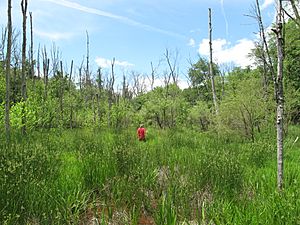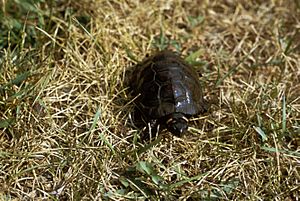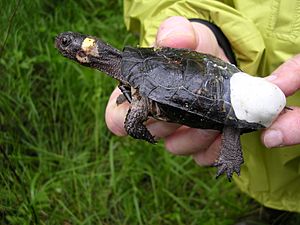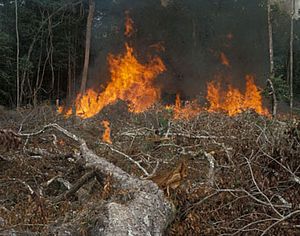Bog turtle facts for kids
The bog turtle (Glyptemys muhlenbergii) is a small turtle found only in the eastern United States. It lives in the northeast and Appalachian Mountains. This tiny turtle is the smallest in North America, growing to about 10 centimeters (4 inches) long when it's fully grown.
Bog turtles are very rare and are an endangered species. They are in danger because their homes (called habitat) are disappearing. Also, some people illegally collect them to keep as pets.
Contents
What Does a Bog Turtle Look Like?
The bog turtle looks a bit like the painted or spotted turtles. But it is actually more closely related to the larger wood turtle.
It's the smallest turtle species in North America. Adult bog turtles usually weigh around 110 grams (4 ounces). They have a dark brown to black head. You can easily spot a bog turtle by the bright yellow, red, or orange patch on each side of its head and neck.
The top shell, called the carapace, often has clear rings on its rough scales (called scutes). Older turtles might have a smoother shell. The bottom shell, called the plastron, is also dark brown or black with some lighter marks.
The spotted turtle and painted turtle look similar to the bog turtle. But the bog turtle is special because of that colorful blotch on its neck. Also, unlike the spotted turtle, the bog turtle's upper shell doesn't have any bright colors.
Male bog turtles are usually a bit longer than females. Males average about 9.4 cm (3.7 inches) long, while females average 8.9 cm (3.5 inches). Males also have a larger, more squared head. The male's plastron is slightly curved inward, while the female's is flat. Males have a longer, thicker tail.
Where Do Bog Turtles Live?
Bog turtles live in bogs and other wet areas called wetlands. They like meadows, marshes, and places where springs bubble up. These spots usually have both wet and dry parts. Their homes are often found near the edge of forests. Sometimes, you might even see them in cow pastures or near beaver dams.
They use soft, deep mud to hide from animals that might try to eat them and to stay safe from bad weather. It's important for their habitat to have an open area above them. This is because bog turtles spend a lot of time warming up in the sunlight.
Northern and Southern Groups
There are two main groups of bog turtles: a northern group and a southern group. They are separated by a big gap of about 400 kilometers (250 miles) in Virginia.
The northern group is larger. These turtles live in states like Connecticut, Massachusetts, and Maryland. Sadly, there are fewer than 200 suitable places left for them to live, and this number is still going down.
The southern group is much smaller, with only about 96 known groups. They live in North Carolina, South Carolina, Georgia, Virginia, and Tennessee. About 90% of the mountain wetlands in this area have dried up. These turtles are even more spread out and live at higher places, up to 1,373 meters (4,505 feet) high.
How They Evolved
Scientists have only found two bog turtle fossils. This tells us a little about their ancient past. Studies of their mitochondrial DNA show that bog turtles don't have much genetic difference between their groups. This is surprising because they live in small, separate groups.
Scientists think that bog turtles faced a big drop in their numbers a long time ago. As glaciers melted, they moved back into their northern homes. This might explain why there isn't much genetic diversity. The northern and southern groups are now genetically separate. This likely happened because of farming and habitat loss in Virginia during the American Civil War.
How Bog Turtles Live and Behave
Behavior
Bog turtles are mostly active during the day (this is called diurnal). They wake up in the morning, warm themselves in the sun, and then look for food. They are shy, so it's hard to see them in nature. On colder days, they hide in thick plants, underwater, or buried in mud. This shows they can survive without oxygen for a while.
On warmer days, they search for food, mate (in early spring), and bask in the sun. They spend a lot of time sunbathing but usually hide from the sun during the hottest part of the day. If it gets too hot, they might go underground into water-filled tunnels. At night, they bury themselves in soft mud.
From late September to March or April, bog turtles hibernate. They might hibernate alone or in small groups, sometimes with other types of turtles. They look for dense soil or strong root systems to stay safe during this sleep period. They come out of hibernation when the air temperature is between 16 and 31 degrees Celsius (61 and 88 degrees Fahrenheit).
Male bog turtles can be territorial. They might try to chase away other males that come too close. If another male doesn't leave, they might push and bite. Females also defend their nests from other females.
What Do Bog Turtles Eat?
Bog turtles are omnivorous, meaning they eat both plants and animals. They mostly eat insects and their young (larvae). They also eat aquatic plants like duckweed, seeds, berries, earthworms, snails, slugs, other small creatures without backbones, frogs, and other small animals with backbones. Sometimes, they even eat dead animals. Insects are usually their most important food. They only eat during the day, but rarely during the hottest hours.
Who Eats Bog Turtles?
Many animals prey on bog turtles. These include snapping turtles, different types of snakes, muskrats, striped skunks, foxes, dogs, and raccoons. Their shells don't offer much protection. When threatened, a bog turtle's main defense is to bury itself in soft mud. They rarely fight back or bite.
Bog turtles can also get sick from bacteria. Leeches and parasitic flies can also bother them, causing blood loss and weakness.
How Do Bog Turtles Move?
Bog turtles don't move much day-to-day. They usually bask in the sun and wait for food. But they are often more active after it rains. Studies show they move a few meters each day. Both males and females can find their way back home even if they are moved up to 0.8 kilometers (0.5 miles) away. If their home becomes unsuitable, they will travel long distances to find a new one. Males generally travel more than females, especially when defending their territory.
Bog turtles can move both on land and in the water. Most of their movements are short, less than 21 meters (69 feet). Long trips between different wet areas are rare.
It's important for bog turtles to move between different groups. This helps keep their genes diverse. If they can't move freely, their chances of becoming extinct increase. Scientists are still trying to understand why bog turtles move outside their usual homes and how far they travel.
Life Cycle
Bog turtles can start having babies when they are between 8 and 11 years old. They mate in the spring after they come out of hibernation. During courtship, the male gently bites and nudges the female's head. The whole process usually takes about 35 minutes. Females might mate once, twice, or not at all in a season. Males try to mate as many times as possible.
Nesting happens between April and July. The female digs a hole in a dry, sunny part of the bog. She lays her eggs in a clump of grass or moss. The nest is usually about 3.8 to 5.1 cm (1.5 to 2 inches) deep. Most bog turtle eggs are laid in June. Pregnant females lay one to six eggs at a time (usually 3). They only lay one group of eggs per year. A healthy female can lay between 30 and 45 eggs in her lifetime. However, many baby turtles don't survive to become adults. Older females usually lay more eggs. The eggs are white and oval-shaped, about 3.4 cm (1.3 inches) long. After the eggs are laid, they hatch in 42 to 80 days. In colder places, the eggs stay in the nest through winter and hatch in the spring. Eggs are in danger from animals, floods, or frost.
Baby bog turtles are about 2.5 cm (1 inch) long when they hatch, usually in late August or September. Females are slightly smaller at birth and grow slower than males. Both grow quickly until they are mature. Young turtles almost double in size in their first four years. They are fully grown by five or six years old.
A bog turtle usually spends its whole life in the same wetland where it hatched. In the wild, they can live for 50 years or more, but the average lifespan is 20–30 years. The Bronx Zoo has some bog turtles that are over 35 years old. You can tell a bog turtle's age by counting the rings on its scutes, not counting the first one.
How We Protect Bog Turtles
The bog turtle is a threatened species under the United States Federal Endangered Species Act. This means it's protected in many states like Connecticut, Maryland, and New York. The southern group is also considered threatened because they look similar to the northern group. Many states also list the bog turtle as endangered or threatened.
About 80% of bog turtle groups that existed 30 years ago have disappeared because their habitat has changed. Because they are so rare, bog turtles are often illegally collected for the worldwide pet trade. Even though it's against the law, poachers still take them. Cars on roads also cause declines. The U.S. Fish and Wildlife Service has a plan to help the northern group recover. In 2011, the bog turtle was listed as critically endangered on the IUCN Red List.
Non-native plants are a big threat to bog turtles. Plants like purple loosestrife, reed canary grass, and reeds grow very thick and tall. They make it hard for turtles to move. These plants also take over from native plants, reducing food and hiding places for the turtles.
New neighborhoods and roads block the turtles' movement between wetlands. This stops new bog turtle groups from forming. Pesticides, runoff from land, and waste from factories also harm the turtles' homes and food supply.
Today, helping bog turtle groups recover often depends on private efforts. Scientists carefully survey land to find suitable places for bog turtles. They also use special technology to compare known bog turtle habitats with potential new ones.
To help existing groups, several private projects are working to stop trees and bushes from growing too much. They also try to prevent new roads and neighborhoods from being built.
Some ways people help recreate bog turtle habitats include:
- Using controlled burns to limit the growth of tall trees and bushes. This helps the habitat stay open and sunny.
- Letting animals like cows and goats graze in the area. This creates wet spots and churned mud that turtles like.
- Encouraging beaver activity, including building dams near wetlands.
Captive breeding is another way to help increase bog turtle numbers. This means mating bog turtles indoors in special environments where they get good food and mates. The first people to do this were Fred Wustholz and Richard J. Holub in the 1960s and 1970s. They released many healthy bog turtles into the wild. Organizations like the Association of Zoos and Aquariums are also allowed to breed bog turtles in captivity.
Studying bog turtles in the wild is very important for conservation. Scientists use radio telemetry to track their movements. They also collect blood, waste, and other samples to check for diseases.
See also
In Spanish: Glyptemys muhlenbergii para niños
Images for kids
-
Striped skunks prey on the bog turtle.










